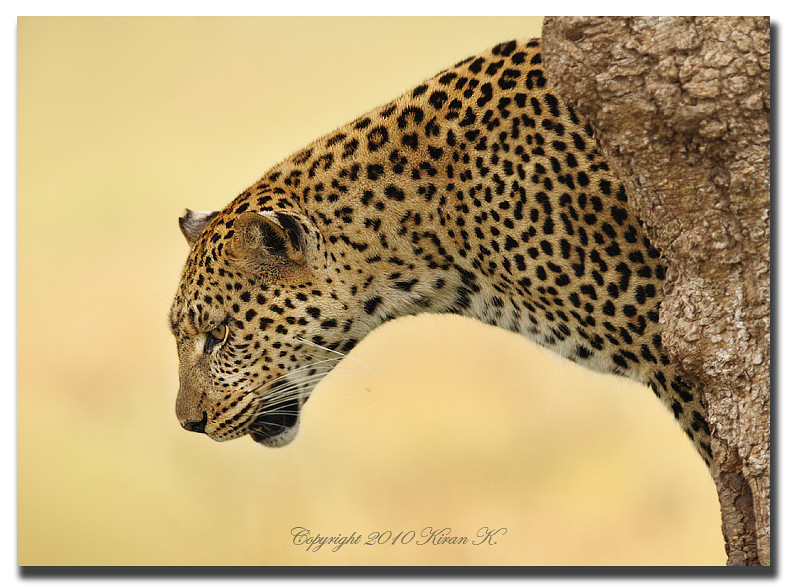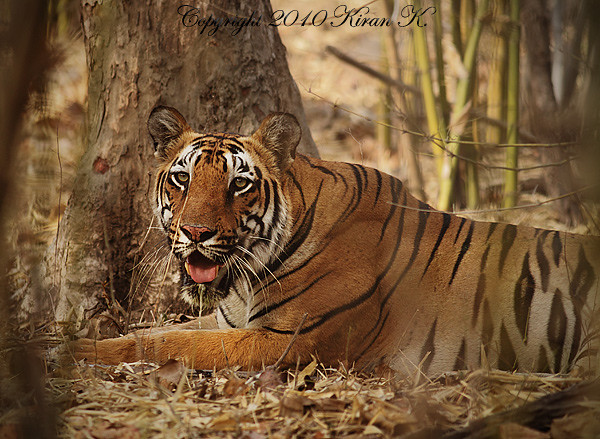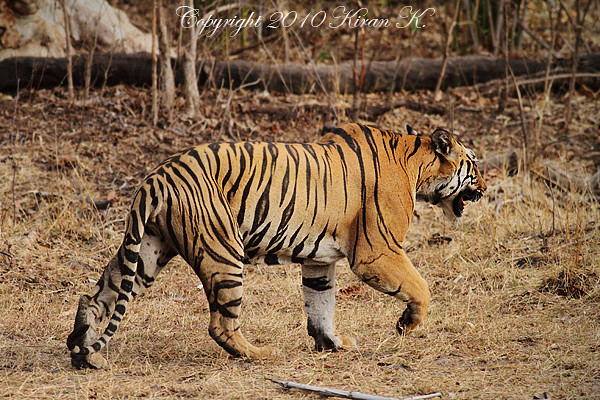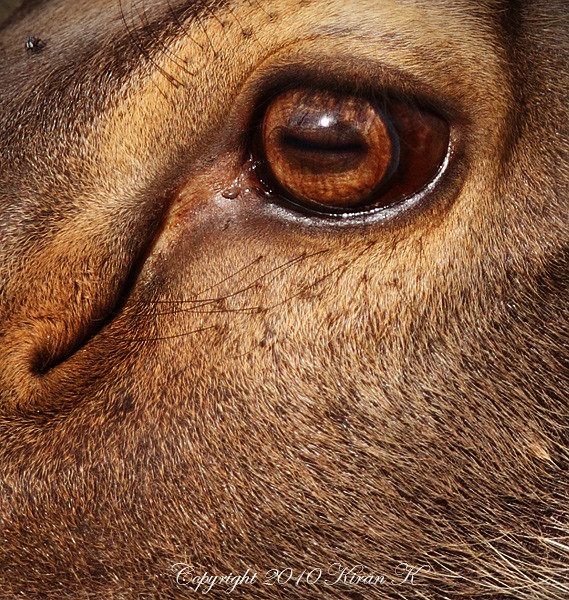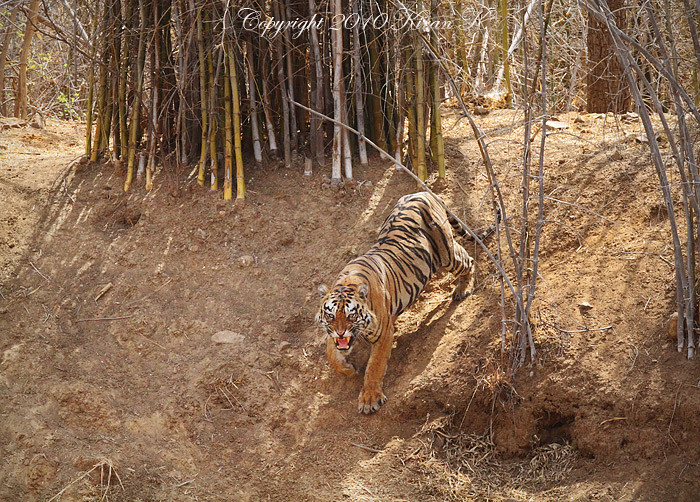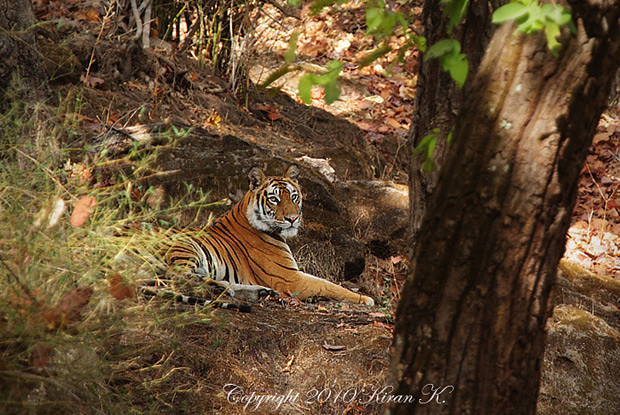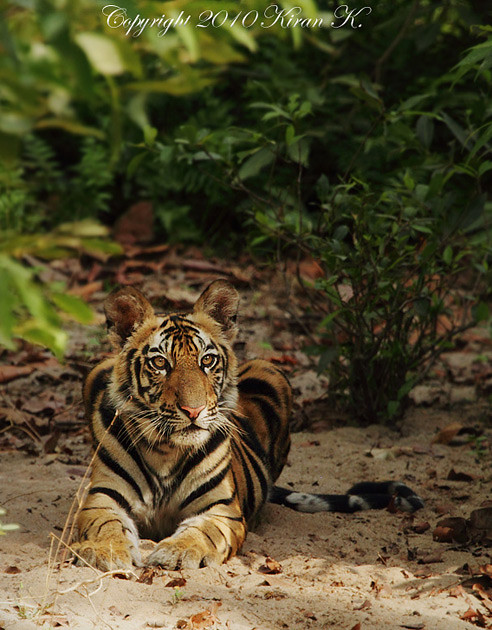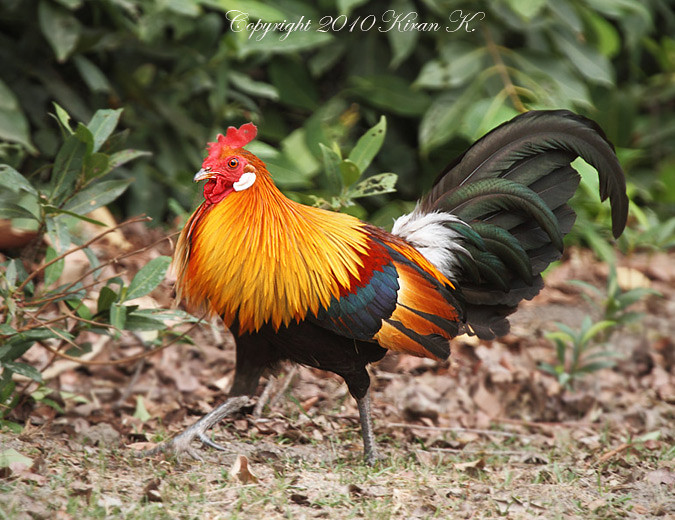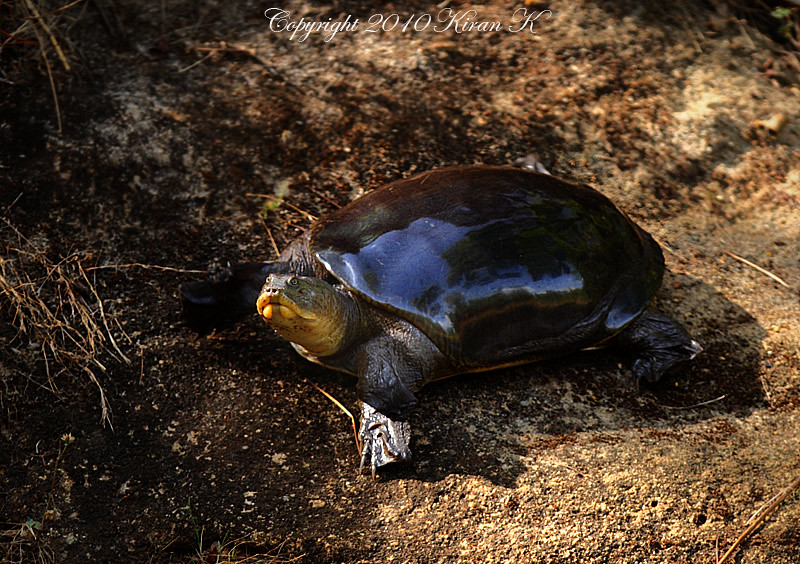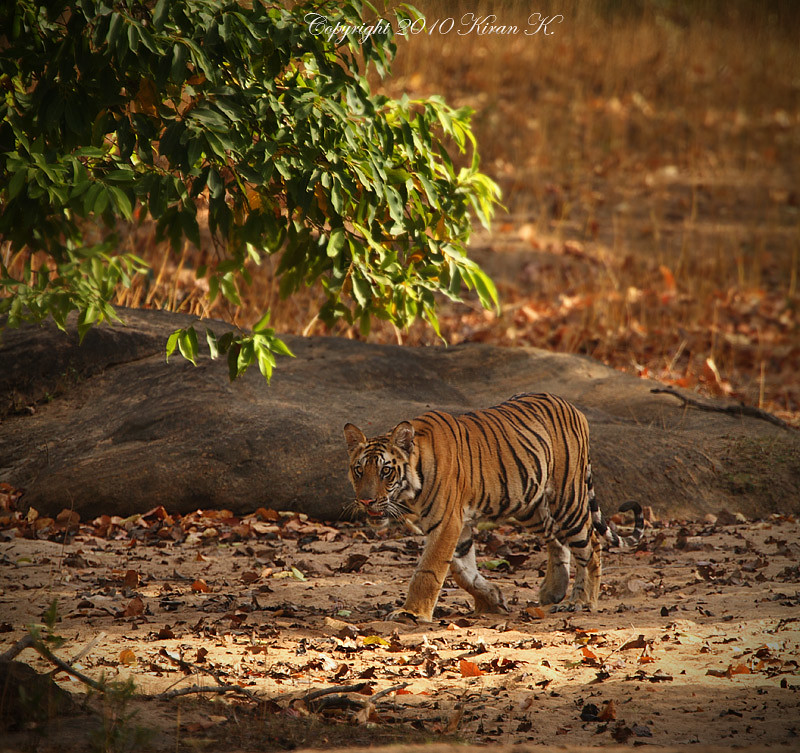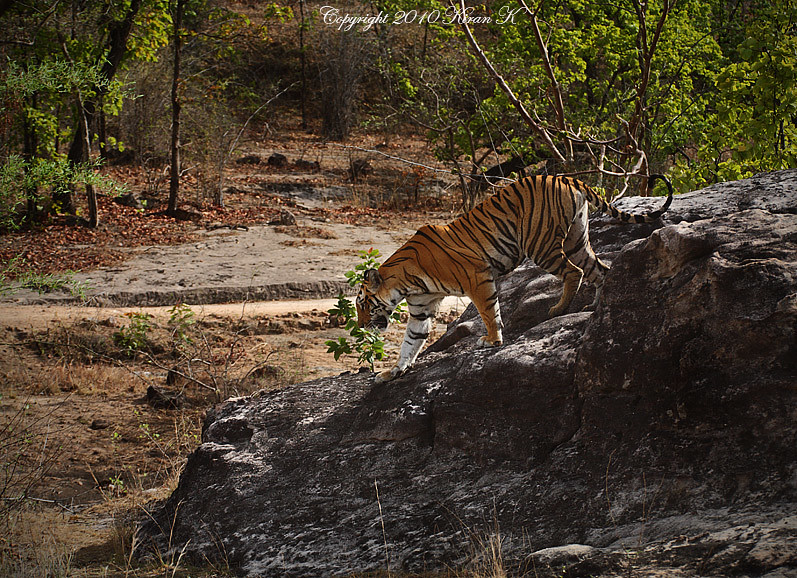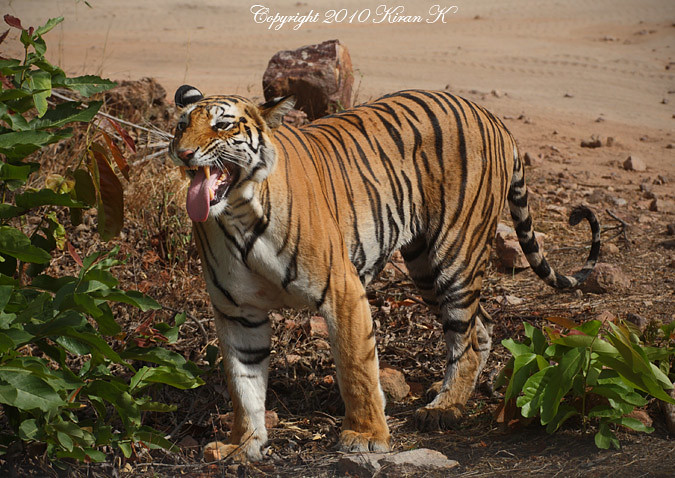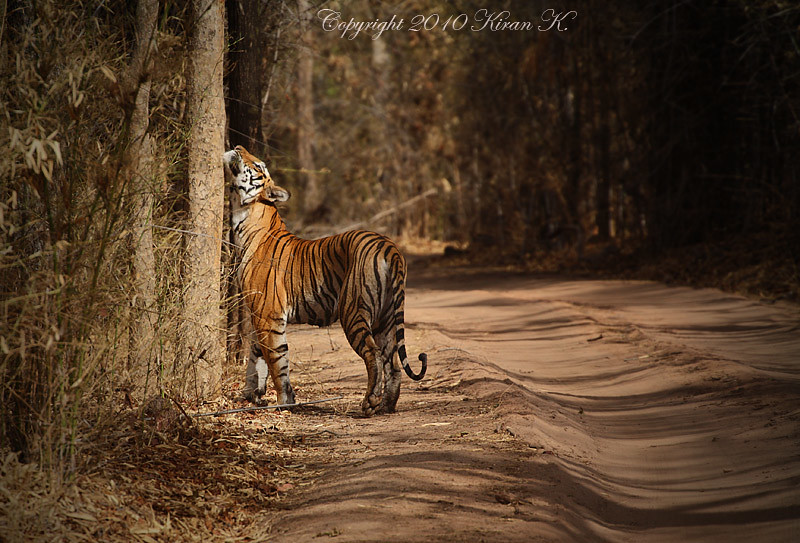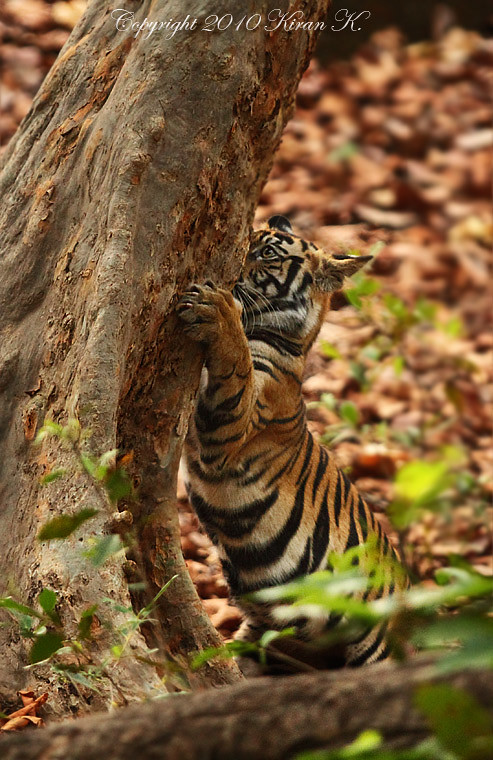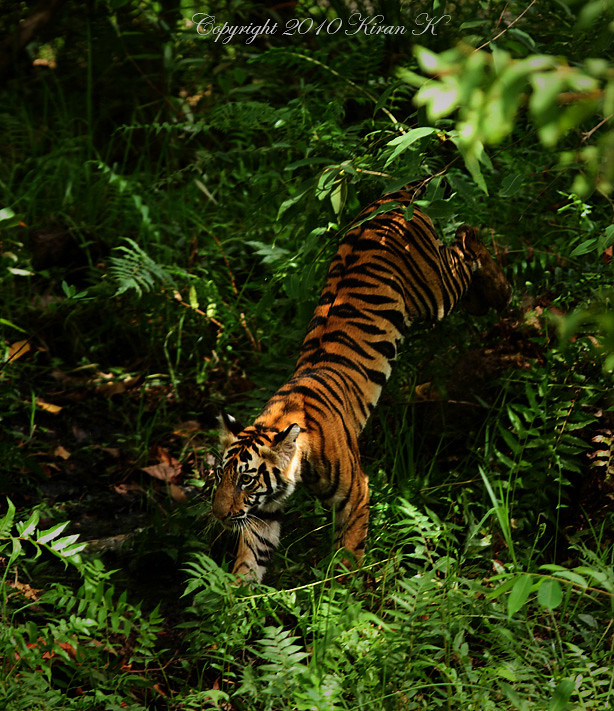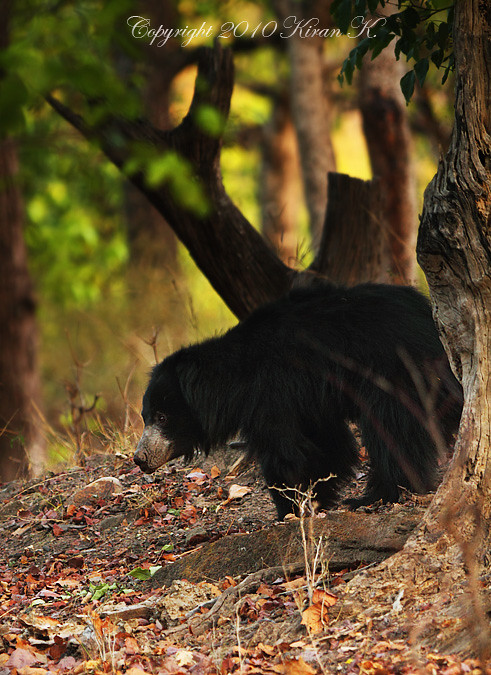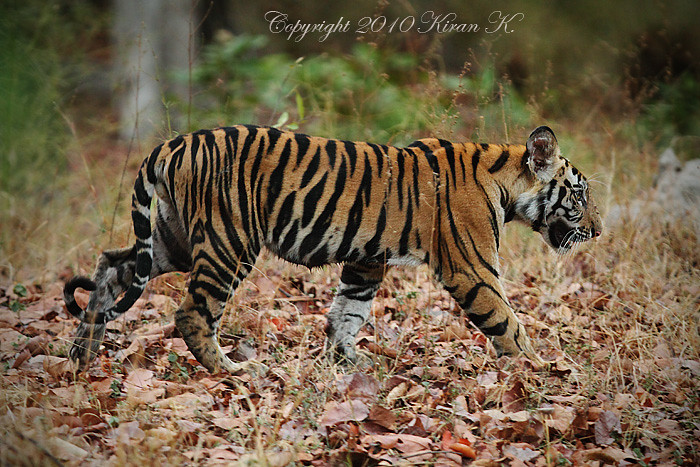Big Cat Photography
This is the blog of Wildlife Photographer Kiran Khanzode. Here, you can stay up to date with information about my trip reports to India, Africa, read tips/techniques, view my image gallery and also stay informed about Workshops/Photo Safaris.
Friday, August 13, 2010
Subject Isolation And Background
While posting an image for critique on some online forums today, I felt that I could share some tips about subject isolation and background that I (try to) use in practice while taking a picture.
It is not always possible to take a picture with the cleanest of backgrounds, especially when shooting wildlife. You take what you can get or try to work the scene in some way that you get the desired effects (in-camera). The least amount of post-processing work makes me the happiest.
First and foremost, a wide aperture lens (200 f/2 or 300f/2.8 or even 500 f/4) is your best friend for creating a shallow DoF and for creating that dreamy background blur or 'bokeh' seen in professional photographers' work. Ideally, if you can get close to your subject and create more distance between the subject and the background (choose your backgrounds wisely, wherever you can), you can get great subject isolation just like a pro where the background melts into a buttery smooth backdrop, gluing the viewer's eyes on the focal point of the image(your subject) instead of having distracting elements (in focus) in the background.
Eg: Take a look at this picture of the Leopard who was high up on that tree in Serengeti on that cloudy day (Cloudy days are good for photography, lighting is even, there are no harsh shadows). Had I take this same picture from the window of my vehicle without getting up on the roof, I would have included dull overcast sky as my background (not desired)and the angle of approach wouldn't have been flattering either. Instead, I chose to get up on the roof of the vehicle, get at eye level of the animal and include the dry brown grass in the background.
Thankfully she was close enough for a 300 mm focal length and the endless plains(uniform in color) in the background made it easy as well. The rest of the job was simple, I shot this picture and others in the series at very wide apertures (f/2.8, f/3.2)which guaranteed a soft, smooth background blur creating a desired effect as required in a portrait. The separation/distance between the subject and the background was so much here that a 300mm f/4 lens could also have done a great job in the situation.
You can apply the same principle for human photography too (especially portraits). Do remember to take as many compositions (horizontal, vertical) as you can from the same scene, provided your subjects allow you the time to do so.
Happy clicking !!!
Wednesday, June 30, 2010
Trip To Tigerland - May 2010
Hi, Everyone,
Just came back from an awesome trip to Tigerland, India. Daytime temperatures in the peak of summer soared above 115 degree F routinely, but it was all worth it. I visited two National Parks / Tiger Reserves this time around. Tadoba Andhari Tiger Reserve( TATR) and Bandhavgarh Tiger Reserve / National Park (BNP).
Here's a sample of how I was welcomed by the thirsty Tigers of Tadoba Andhari Tiger Reserve. :-)
Tadoba was the first park that I visited in this trip. It is about 150 Km from Nagpur by road. After about 32 hours, tired and exhausted, we reached Nagpur, my hometown. The transition from balmy 65 degree F to 110 deg F was indeed jarring but still a lot of fun.
Made a quick trip to the stores for supplies (food,water, mangoes) for the upcoming trips, met a few friends for dinner and started for Tadoba around midnight the same evening from Nagpur with a couple of friends and fellow photographers. The drive to Tadoba was pretty smooth and we made it to the buffer zone of TATR at around 4am. A quick drive around the buffer zone routes to locate the elusive Leopard or any other nocturnal cat turned futile and before we knew it, we were in queue at the Mohurli Gate, ready to get in for the morning drive. Our plan was to stay in Tadoba for 3 nights.
Day 1# : Due to intense tourism pressure because of many tiger cubs being born this season at this reserve, the authorities had recently closed down many routes in the Mohurli Range. A common problem, call it a design problem, in Tadoba is the close-to-road man-made waterholes(literally within 30 feet from the road) that have been built for Tigers and other wildlife to come and pacify their thirst. What happens is...people get too close, I mean *too close* to wildlife and disturb them, inadvertently causing them to flee from the waterhole. Imagine being a wild animal, having no other water source to drink from in the sweltering heat of summer and on top of that being disturbed. Kudos to the TATR folks for temporarily disallowing any jeeps to get to these waterholes !
Anyway, my first impression upon entering the park was that the entire region seemed deprived of water, the landscape appeared completely devoid of life, trees had no leaves, everything was dry/brown. It was quite the opposite of what one gets to see in the months of winter (Nov-Feb) when all animals appear healthy in their winter coats and the grass is lush green, there's plenty of water, the forest has a life of its own and then there's the added mist/fog in the early mornings that can be heavenly (especially in places like Kanha National Park, MP). Oh well, back to reality, it's the peak of summer and I am in Tadoba....nothing changes that, let's go and find some wildlife.
We took one of the two open roads in the Mohurli range and missed a Tiger by a couple of minutes(argh !), however we caught a fleeting glimpse of this Sloth Bear crossing the safari track.
I prayed for him to turn and make eye contact, alas...it did not happen. Well, I was happy that we sighted the bear ( it always feels good to start your trip by clicking some shutters within a few minutes after entering the park) :-).
The rest of the morning was spent trying to find the Tiger that we had missed earlier at the Telia Lake. Saw these Blue bulls instead, they bolted as soon as they saw us approaching from a distance.
The light was getting harsh at about 8:30 am or so and it was getting hot as well, so we decided to head back. We checked-in at the state-run MTDC resort, a place much less sophisticated as compared to the resorts run by the adjoining state of Madhya Pradesh. Well, all we needed was a room with AC and quick access to the park entrance, and this MTDC place did serve that purpose. Did I mention good food was also a requirement ? That definitely was met at MTDC, delicious food, great chicken !!
Our afternoon safari was in the adjoining Kolsa Range. The temperature was at its peak, some 48+ degree C, it was pretty unbearable. We spotted this huge tigress sitting in the shade of bamboo trees trying to get respite from the summer heat. Since there was a lot of clutter all around, I decided to go in tight with my 300mm focal length.
She eventually got up and moved towards a water source. Here's one more picture of her, look at the size !!! I didn't get anything mind-blowing or artistic out of this session, but sometimes the sheer joy of seeing such a majestic animal in its environment trumps it all.
The next morning's safari got us a couple of Tigers in the Tadoba Range (the 3rd range of the park). Here's a Sambar female that came too close, I tried this tight crop to emphasize the eye details and create an abstract.
As we reached the Yenbodi waterhole, there was a crowd gathered and we knew the reason for it. This Tigress was sitting there and she was very calm, doing her own thing, the presence of the crowd did not bother her. She looked at everyone calmly, drank water, sat in the pool and left after a short while.
Seeing that she was giving us enough time, I move to a 600mm focal length. The light wasn't the world's best...oh well.
While tracking a Leopard with alarm calls going on, we saw this Eurasian Thick-Knee.
After catching a quick 5 second glimpse of a Leopard, we came back to the Yenbodi waterhole to see this male entering. He was a bit timid and hence the expression on his face.
I must say that due to the harsh lighting in the daytime, I actually took more videos with my 7D and Canon HD cam than I took pictures this time around (in Tadoba).
In our last safari round the next day, we saw a Sloth Bear foraging for food right by the road side. Usually shy in nature, they are pretty approachable in summer time when they are looking for food. Glad I had the sun behind me, I quickly switched to my 2nd body with a 70-200mm mounted since the bear was pretty close to the safari track. We made eye contact and then he quickly ran across the road towards the dense thicket. I was happy with the outcome.
In the end, the trip to Tadoba was productive but I did not make any spectacular images that I was looking forward to making, partly due to the complexities of the sightings I got (time of day, dense brush, harsh light etc), but I did come back with some great memories and moments from this phenomenal place.
Next leg of our journey was Bandhavgarh. 4 photographers boarded the bus from Nagpur to Jabalpur a couple of days after we came back from Tadoba. We reached Jabalpur late that evening due to a fiasco in the bus's engine where fuel was leaking on people's luggage(ouch!). Thankfully, our luggage was ok, we boarded our Toyota Innova from Jabalpur and started towards Tala/Bandhavgarh, a 3 hour journey.
We reached Tala at 2:30am or so, checked in and slept for a couple of hours before it was time for our first safari round. I was under jetlag, so I didn't get much sleep at all. However, I was very excited to come back to Bandhavgarh, I have fond memories of this place from the past and the Tiger sightings here are just superb !! Not knowing what to expect, we queued up in front of the park entrance at 5:00 am, the gates opened at 5:30am.
Within a mile of going in, our talented driver spotted a Tigress sitting on a rocky outcrop in her territory (this is the magic of Bandhavgarh, Tigers are everywhere, you just have to find them). :-)
Here she is, the Chorbehra Tigress, she has 2 cubs currently.
She did give us a few poses, stalked something for a short while but nothing happened. Soon, she moved away from us and went behind the rocks, it was time for us to move on as well.
Not too far away we spotted one of her bold cubs staring right at us from within a ravine. I quickly made some shots because a crowd was beginning to gather to get a glimpse of this pretty looking young tiger.
Bingo ! I finally thought to myself, here's my first image of the trip. The light, the expression on the cub's face and the framing with the leaves was lovely. I gladly made a few more shots of this bold cub, who thankfully, did not run away at the first sight of us. The cub eventually went behind some lantana bushes and we had to move on.
Spotted a bird of prey, Shikra, in good light, waited for the head-turn, click-click. On the right, is an Indian Roller, and in the middle is a Creates Serpent Eagle.
 |  |
The round ended with nothing more than a few birds and some deer. We returned to our hotel to take some much needed rest before our evening safari.
In the evening, we tried to locate my favorite Tiger Kallu, I had seen him exactly a year ago and have been photographing him for 2+ years. With high hopes, we spent an hour waiting for him to walk the road in his territory. Nothing happened for long and then eventually only 2-3 jeeps stayed back and stretched their luck to catch a glimpse of this handsome male. It was getting late and within 20 minutes or so we would have to exit the park and were quite a distance away from the gate. Finally, our driver saw this huge beast staring at us from within the bushes. After assessing the situation, he silently walked out of the bushes and on to the road just ahead of our jeep and began his evening walk on the jeep track. There were no alarm calls or anything since that specific area had no Langurs or Cheetal deer. Had the driver not noticed this tiger in the bushes, he would have passed by unnoticed.
Some people dislike animal images which include man-made elements like roads,walls etc, but sometimes, there's no choice since Tigers love to walk on the soft,sandy roads. They leave their pugmarks in the soft sandy soil which makes it easy for us to find them. I have no complaints...
Anyway, after this quick 5 minute sighting, we eventually sighted Kallu 1 more time during the trip. Here's a few images of him.
 | 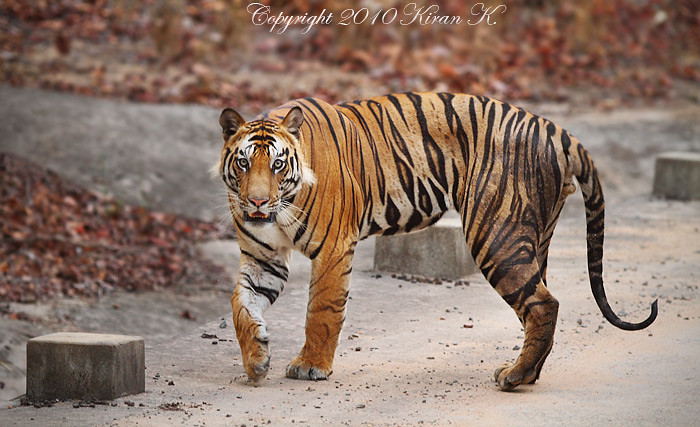 |
The next couple of rides were spent trying to locate B2, the legendary Tiger of Bandhavgarh, but we missed him by minutes. It was painful to hear the fading alarm calls of deer and langur and being informed by others that the Tiger had just passed by. Oh well !
We did sight one of the Mirchaini cubs one morning though, it ended our 1 day drought and was a welcome sighting. This bold cub was walking in the Damnar nullah straight at the waiting tourists. He eventually took a turn inside the thicket and crossed the road, but he appeared in no hurry. Usually cubs of this size will try to avoid humans and run/hide. He's gonna be one big, bold tiger, someday.
A couple of days went by with no major sightings, but we did not lose hope.
Our luck changed completely on the last morning, it was a photographer's dream entry into the park. By that I mean, as soon as we entered, within a mile of the gate, the guide spotted fresh pug marks of a huge male going in the direction that we were going. Our hearts started racing with the excitement and anticipation of seeing B2 or the Bamera Male, another huge tiger who is currently challenging B2, his father and trying to take over and become the alpha male.
Within a few minutes of driving, after passing by the Sidhbaba temple, the guide shouted in Hindi "Wo Waha baitha hai" (There he is, sitting !). Those golden words sent us in a frenzy, everyone was trying to reach for their cameras and to get ready, not to miss this opportunity of photographing a Tiger in the golden hour of early morning. What we saw next was simply superb and in a glorious setting.
It was early morning, we were the first jeep to arrive in the Chakradhara grasslands and there he sat, the Bamera male, a huge-huge tiger, seated like the King he was, undisturbed and nonchalant. Luckily for us, he chose an area which was wide open. We parked within 50 feet of him and began shooting some portraits before he put his head down and went back to sleep. Oh, no !
Soon, the other jeeps started arriving and everyone was going nuts seeing this massive tiger so early in the day. After a few minutes of dozing, he eventually got up, started walking towards us.
This was the money shot for me from this trip, I liked it so much that I've used it on the brochure for India Safaris.
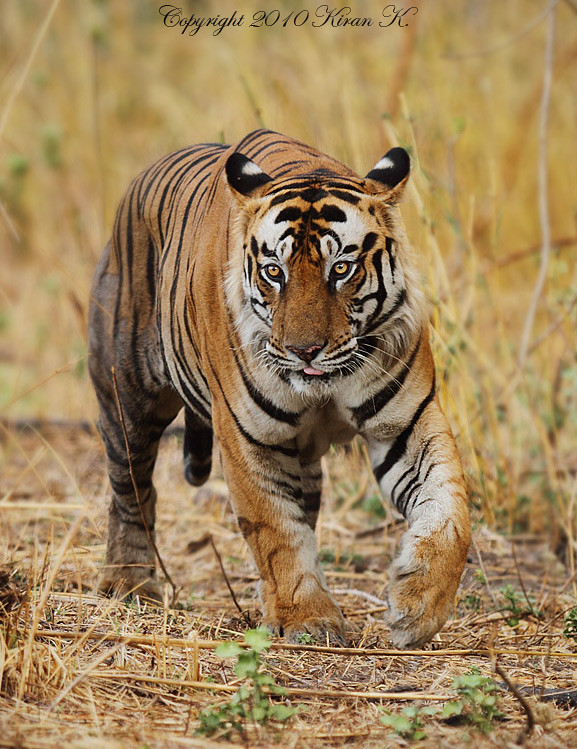 | 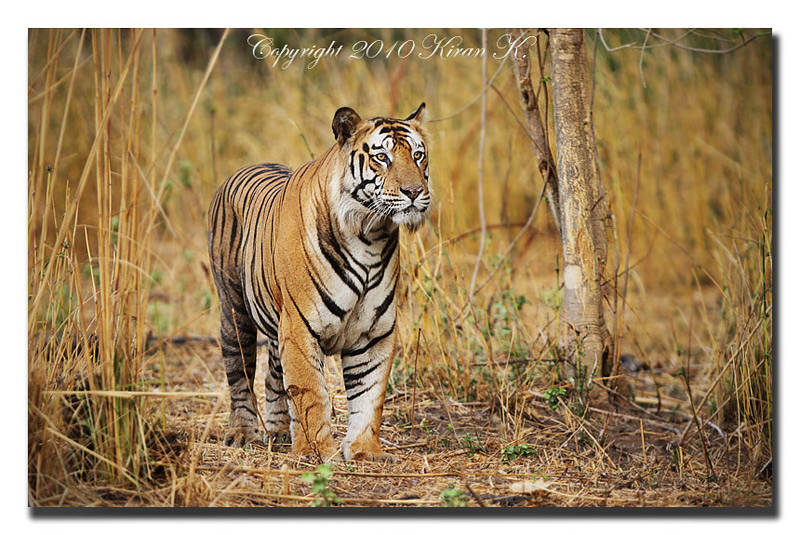 |
 | 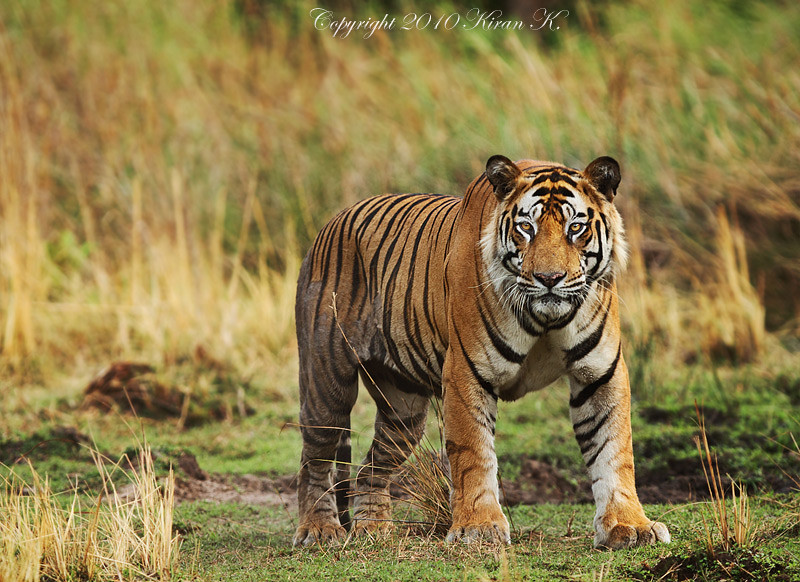 |
We then headed towards Ghoda Deemon, an area frequented by B2 and Kalua. After pausing for a few minutes at an intersection a hundred yards off of Ghoda Deemon, we asked a jeep driver who was headed in that direction to signal us if there was any tiger in the area. Usually, they let out a whistle as a signal. We waited for 5 minutes and nothing...no whistle. Our driver almost made a U-turn and was about to go in the other direction when the guide asked him to take the vehicle in the direction of Ghoda Deemon, just in case. Reluctantly, he did. After crossing about hundred yards on that road, the guide noticed a tigress on the left, in the valley. The jeep that went ahead of us had clearly missed her while she was scent marking around some bushea. Kudos to our guide for locating her out of nowhere !!
We quickly moved ahead, anticipating her general direction and ended up coming face to face with her. It was amazing to be the only ones present around her and to watch this Tigress go on with her business. She was the Mirchaini Tigress, mother of Kalua. She came right next to our jeep and did the Flehmen Display. Her tongue came out, teeth bared, eyes squinted, it was awesome to see it up close. We quickly took some behavior shots (sadly, she was too close for any compositional consideration) before she moved away and walked on the road briefly, scent marking and rubbing her chin on some trees. Soon she disappeared in the deep brush and we lost track of her. This lasted for about 15 minutes and we were all very happy to see the 2nd tiger within a span of couple hours. Little did we know there was more to come.
After reporting at the Center Point(a place inside the jungle where all jeeps entering the park have to register their entry), we started heading back towards the gate. At the intersection of Sidhbaba territory, we noticed that a few jeeps were parked. We quickly went there and saw the Sidhbaba cubs (2 young cubs of 12 months age) playing in the Lantana. It was a challenging situation due to the low light and deep undergrowth, however it was fun to capture some cub moments. Spent 10-15 mins watching them before it was time to exit the park. Tiger count for the morning = 4 !!
Seen here is one cub trying to mark a tree and another running around.
That evening was our last drive in the park. We waited for the Bamera Male to show up but he did not. However we did see a Sloth Bear.
Nothing sensational happened after that or so we thought...
Right before exiting the park, the Sidhbaba family crossed the road. Light was very low, I framed a few shots with my 300mm and got a few keepers. Here's one of the cubs just before he crossed the road.
Overall, we had our highs and lows during the trip, however, we were very happy with the sightings that we had even though half of the park was closed due to an accident earlier that month where a forest department vehicle had hit a Tigress in the night(Jhurjhura female). She died the next day leaving three 4 month old cubs at the mercy of nature. I had seen and extensively photographed this female in my past two trips since 2008 and was very sad to hear about her demise. The FD is currently taking care of the cubs and trying to rear them up, but it is going to be tough. God bless the Jhurjhura family.
Subscribe to:
Posts (Atom)
